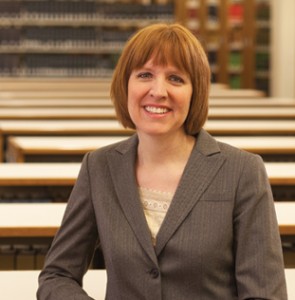BYU law professor RonNell Andersen Jones passes on to her students lessons she learned at the Supreme Court.
 Megan A. Grant (JD ’10) and Stephanie H. Barclay (JD ’11) sat on the dark wood benches of the Supreme Court, watching BYU law professor RonNell Andersen Jones at the counsel table during the oral argument of Kucana v. Holder, a case dealing with technicalities of illegal immigration. “I was nervous, but I was also so excited and so proud,” says Barclay.
Megan A. Grant (JD ’10) and Stephanie H. Barclay (JD ’11) sat on the dark wood benches of the Supreme Court, watching BYU law professor RonNell Andersen Jones at the counsel table during the oral argument of Kucana v. Holder, a case dealing with technicalities of illegal immigration. “I was nervous, but I was also so excited and so proud,” says Barclay.
Jones had orchestrated an unparalleled learning opportunity for her research assistants: after she received the assignment to work on Kucana v. Holder, she employed seven students to be her pseudo-appellate law firm. After three months researching for the brief and role-playing for the case, Jones took four of the students with her to Washington, D.C., to attend the oral argument, meet Justice Sandra Day O’Connor, and take a behind-the-scenes tour of the Supreme Court.
Barclay says the only students she has met who have had similar experiences attended Harvard Law School. “Even attorneys who had long careers hadn’t been . . .involved in a Supreme Court case from the beginning all the way to fruition,” she says. “I felt extraordinarily lucky.”
Providing such extraordinary experience is Jones’ first professional priority. Jones, after all, remembers being a law student. “The pressure is intense, and people deserve to be mentored—to be cared about,” she says.
Jones was mentored herself by one of the biggest names in law: Supreme Court justice Sandra Day O’Connor. As one of four clerks in the 2003–04 term, Jones clerked during a string of high-profile cases, including the first on the war on terror. The magnitude of the workload kept her at her desk six days a week. “It was only for religious reasons that I wasn’t working Sundays,” Jones says. “[Justice O’Connor] was very respectful of my religious convictions.”
Jones spent all her time at the court compiling research for Saturday luncheons where O’Connor and the clerks discussed—and debated—each case. Before each luncheon, Justice O’Connor got up early to make authentic southwestern cuisine. O’Connor’s position on the court as a swing vote made her arguably one of the most powerful people in America, says Jones. “Still she was getting up early to make enchiladas and wanted to hear about our kids and personal lives.”
Jones says O’Connor was one of those “key people who represented a real turning point” in her life, and Jones uses the same patterns to mentor her own students. Her first semester teaching at BYU, Jones put sign-up sheets outside her office for luncheons with students. Grant participated in the very first lunch group with Jones. “It was the first time I had done something like that with any professor,” Grant says.
Jones learned the value of close mentors in her interactions with Justice O’Connor. After her clerkship, Jones and O’Connor team-taught courses in constitutional law at the University of Arizona for six years. On the trip to Washington, Barclay observed Jones and O’Connor’s interactions. “It surprised me how sweet [O’Connor] was with Professor Jones,” she says. “It was almost like they had a mother-daughter relationship.” For many students, Jones has played a similar role. While she loves the challenges of the academic world, Jones says the chance to work with students is what gets her out of bed each morning: “I hope to be the kind of professor that students can count on.”








